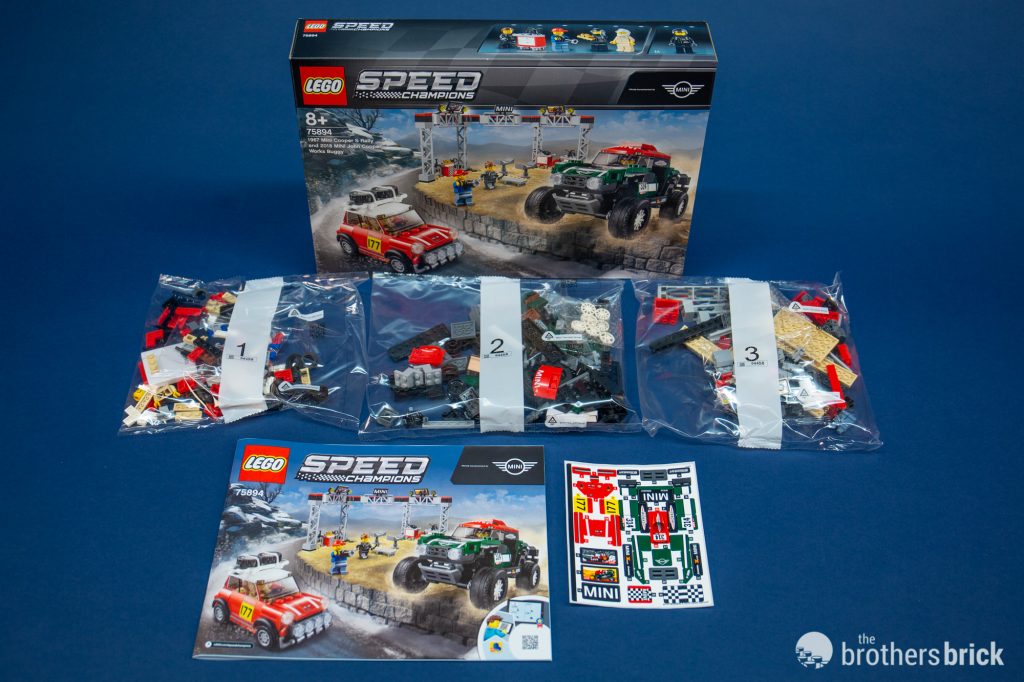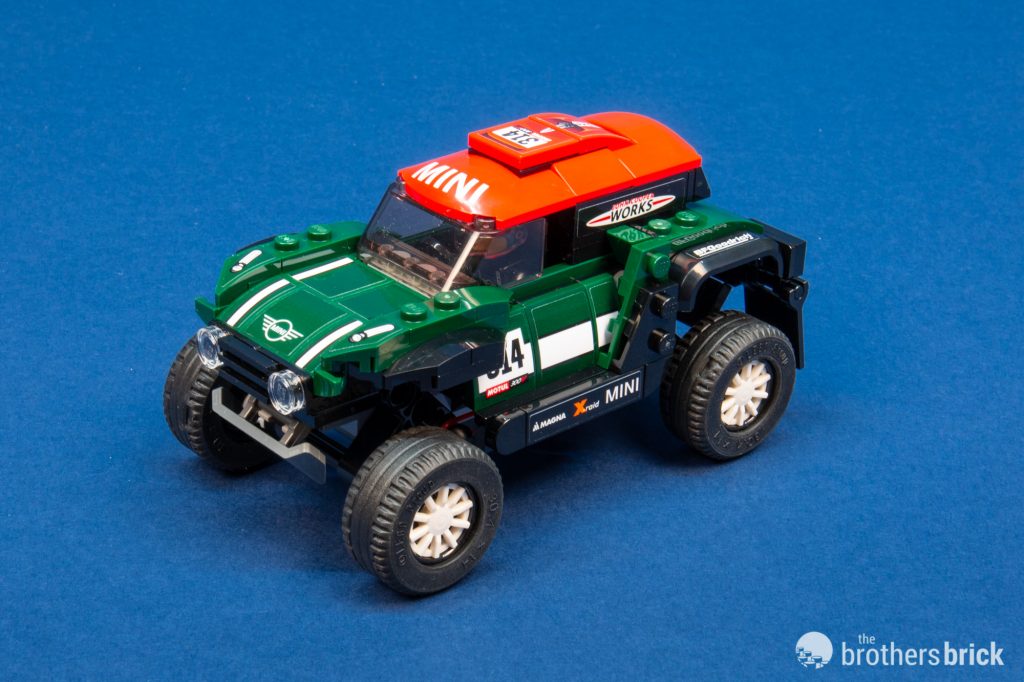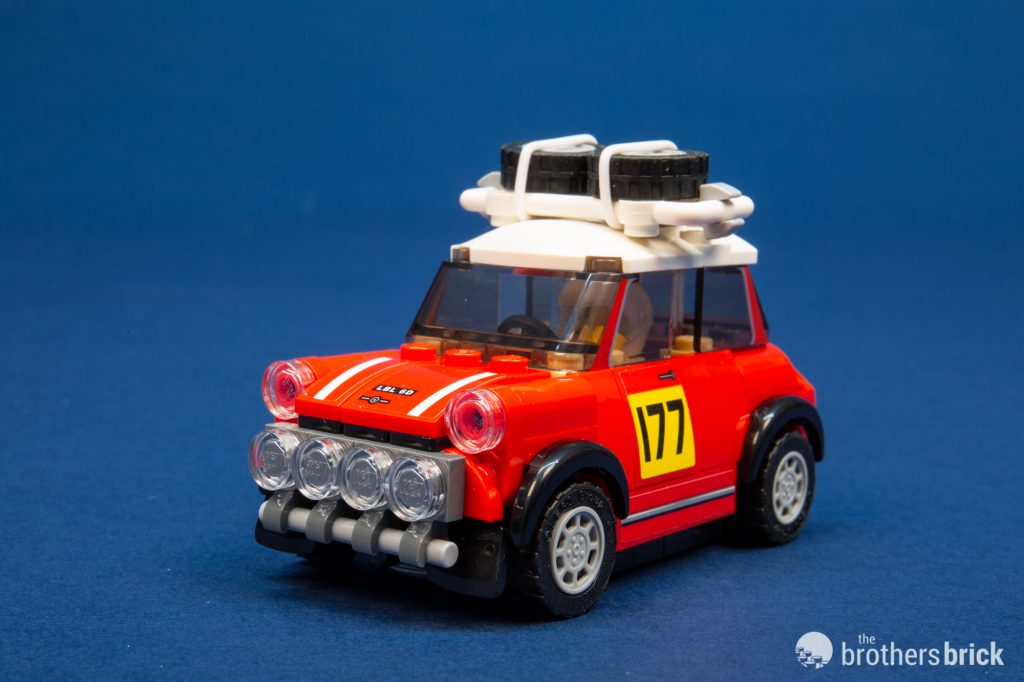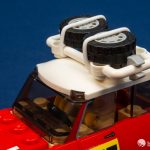For a couple years now, certain LEGO Speed Champions sets have begun depicting specific historical vehicles, such as the stunning pair of Ford winners from Le Mans in 75881 2016 Ford GT & 1966 Ford GT40 released in 2017. The LEGO Speed Champions lineup for 2019 includes another pair of specific racing cars, 75894 1967 Mini Cooper S Rally and 2018 MINI John Cooper Works Buggy, which depicts the winning car from the 1967 Monte Carlo Rally and one of the BMW X-raid team’s entrants in the 2018 Dakar Rally. To be released on January 1st, the set includes 481 pieces and retails for $49.99 in the US (£44.99 in the UK and $69.99 in Canada).
The box, packaging, and sticker sheet
Speed Champions packaging is nothing special, with the front featuring the cars included in the set in dynamic action and the back showcasing more angles of the cars, working features, and photos of the real-life vehicles.
The parts in the set come in three numbered bags — one each for the 1967 Mini, 2018 MINI buggy, and the backdrop.
As with all Speed Champions sets, there is an extensive sticker sheet that provides accurate livery and technical details for each car, along with signage and TV screens for the backdrop.
The build
Both the original Mini from British Motor Corporation (and its successors Morris, Austin, and so on) and the modern MINI from BMW are truly tiny cars. Most LEGO Speed Champions sets depict rather large supercars, so it’s no surprise that creating an original Mini at the same scale should require some rather innovative building techniques. A standard four-wide chassis is quickly converted into the base for a five-wide body using jumper plates, with several different kinds of 1×1 and 1×2 brackets and headlight bricks facing out to hold the car’s skin. A tall, clear panel piece holds the white roof in place, though once the car is fully assembled it doesn’t actually seem to affect stability much (I’ve removed the extra interior panel from mine).
The diminutive size of the Mini also required the production of a new, much smaller mudguard piece.
The end result from Bag 1 is an adorable little Mini Cooper S kitted out for the 1967 Monte Carlo Rally, complete with the correct numbering and extra tires strapped to the roof rack (held on solely with rubber bands in another unusual approach rarely seen in official LEGO sets).
The much larger X-raid buggy in the second bag uses larger brackets for the side panels, and a rubber-band + Technic suspension mechanism.
The front bonnet is built entirely upside down, with inverted curved 2×2 slopes attached to a pair of 1×2 Technic brick, which then attaches via their holes to a bracket piece above the front axle.
The finished buggy looks ready to tackle the dunes and rocky riverbeds of South America on the punishing Dakar rally.
The final bag includes the parts for the backdrop, with lights and equipment to tune and repair your rally cars. As in 75889 Ferrari Ultimate Garage, the new roller coaster sections make an appearance as scaffolding — buy enough Speed Champions sets and you won’t even need to buy the LEGO Creator Expert 10261 Roller Coaster (not quite…).
The finished models
As we noted earlier, the original Mini is the 1967 Mini Cooper S that won the ’67 Monte Carlo Rally, down to the LBL 6D license, and #177. Given that, we can probably assume that the driver minifig depicts Finnish “Professor of Rally” Rauno Aaltonen. The new, smaller mudguard pieces work perfectly for this tiny car, and the printed details on the canopy pieces extend the red color scheme up through the front and rear pillars.
One of the most innovative parts uses in the ’67 Mini is the use of minifig cleaver accessories (in black for the first time) as the front mudflaps. The clip pieces for only the two middle lights attach to the body, enabling the side lights to overlap with 1×1 corner curve pieces underneath and the bar below to “float” above the mudguards.
The sticker details continue on the rear, with a GB sticker and a Mini marque next to the single rear light.
LEGO has produced several tiny cars that are obviously Minis, even if they aren’t officially labeled as Minis (as the 2014 10242 MINI Cooper was), and fitting a minifig inside has been challenging at this scale. The driver minifig does fit inside, though he has to keep his hands up in order to do so.
The front half of the roof comes off to provide access to the interior, with the tall clear panel supporting the rear roof section.
If the ’67 Mini is adorable, the 2018 MINI John Cooper Works Buggy is a monster of a rally vehicle. In iconic dark green and white with a red roof, it’s a jacked-up MINI that would be hard to recognize as being in the same family. (As a pedantic side note, “Mini” is the model of the car produced by BMC until 2000, and “MINI” in all-caps is the branding for the car produced by BMW since they acquired the brand that year.) As a demonstration platform for the technology built by BMW and its many partners, the LEGO version features numerous sponsor logos, including John Cooper Works, X-raid, Sparco, BF Goodrich, and Motul. The huge wheel wells almost seem like they’re swallowing the tiny MINI cab on top.
The rubber bands attached to three-pronged Technic liftarms via balljoints give the suspension significant flex, allowing the car to bounce over obstacles.
The rear features large mudflaps and more sponsor logos, but not much else. (It’s interesting to note that the chassis is entirely symmetrical from front to back.)
Like the smaller Mini, the red roof of the MINI buggy detaches so you can place the driver inside. Note that the “MINI” on the 4×3 red roof piece is printed, as is the case with most Speed Champions designs on curved pieces. The four-wide cab doesn’t provide much more room in the enormous buggy than it does in the ’67 Mini.
When I build LEGO Speed Champions sets for myself, I have to admit that I often skip the backdrop bags and sort them into my parts collection for future builds. Nevertheless, the backdrop does provide some fun playability, including a lift/stand for the buggy and several great tool cabinets. Though considerably more functional with drawers and doors, these tool chests don’t look quite as cool as the entirely brick-built but decorative version included in 10264 Corner Garage.
The backdrop itself has some fun details, including a trophy stand, more tools, an oil can, and screens up top displaying scenes from the Dakar and Monte Carlo rally events.
The minifigures
This set includes four minifigs — a driver for each car, a rally official (with the flag), and a mechanic (with a walkie talkie).
The male ’67 Mini driver (who may or may not be Rauno Aaltonen) wears a tan jumpsuit with a Mini logo at his breast, and the race official wears a blue jacket over a red V-neck underneath.
The backs of both torsos are printed with designs that continue from the front, including more Mini branding across the back of the driver’s jumpsuit.
Both of the modern MINI crew members are women, though the No. 314 car was driven by Saudi driver Yazzed Al Rajhi in 2018. They wear identical black jumpsuits with various sponsorship logos. The mechanic in this set has the same head as the mechanic in Corner Garage, with oil or grease framing her face.
Both women also have reversible heads with alternate faces — the driver can wink while the mechanic looks determined.
The back of their jumpsuits also feature sponsor logos, minus BF Goodrich, who apparently didn’t pay X-raid enough sponsorship money (we assume).
Conclusions & recommendation
The LEGO Speed Champions line has provided us with dozens of European supercars and American muscle cars over the past several years, but one of my favorite trends is the way some sets have begun highlighting specific vehicles that raced in actual historical events. Until today, I might have said that my all-time favorite Speed Champions set was 75881 2016 Ford GT & 1966 Ford GT40, followed closely by 75888 Porsche 911 RSR & 911 Turbo. But the 1967 Mini Cooper S Monte Carlo Rally winner in this set might just become my favorite Speed Champions car ever.
While the 2018 MINI is certainly fun, with lots of nice dark green pieces and a fun suspension mechanism, the ’67 Mini is just plain stunning, with innovative building techniques and a gorgeous finished design. Both the techniques and design rival the absolute best we see here on The Brothers Brick from hobbyist builders — unconstrained as we are by the rules of official LEGO designs and playability. This is the highest possible compliment way can pay an official LEGO set — to use a bit of the jargon that flies around our virtual office, “That looks like an AFOL MOC.”
With fantastic models, excellent construction techniques, and super-accurate recreations of real historical cars, this LEGO Speed Champions set is a must-have not just for Speed Champions collectors, but for all LEGO builders and collectors. We can’t wait for everyone to get their hands on this set when it comes out in January and customize the cars even more — just imagine a fleet of Mini rally cars on a LEGO track at your next LEGO convention. Zoom!
LEGO Speed Champions 75894 1967 Mini Cooper S Rally and 2018 MINI John Cooper Works Buggy includes 481 pieces and 4 minifigures. The set will be available January 1st, 2019 from the LEGO Shop ($49.99 in the US | £44.99 in the UK | $69.99 in Canada), Amazon.com, BrickLink, eBay, and elsewhere.
The LEGO Group sent The Brothers Brick an early copy of this set for review. Providing TBB with products for review guarantees neither coverage nor positive reviews.


































































Doesn’t the female driver have a Wyldstyle head? I think I recognize the freckles…
And although i’m not much of an auto gearhead, this set is one of my faves from the Speed Champions theme. A theme which I otherwise often find rather generic…
Excellent! This set jumped near the top of my want list when it was first announced, and it’s edging closer with this review!
That 1967 Mini simply is adorable, most probably my favourite Speed Champions car as well. Just wish it was sold separately, as I’ve got no interest at all in the rest of the set.
As for the cramped driver space it seems the four headlight bricks closest to the driver aren’t actually necessary? Then I’d certainly remove the two next to the steering wheel, so that the driver can have his hands down. (On the box images his hands somehow aren’t up though?) Also got to compliment the printed windows.
“The front bonnet is built entirely upside down, with inverted curved 2×2 slopes attached to a 1×4 Technic brick, which then attaches via its holes to a bracket piece above the front axle.”
Is it a 1×4 or 2 1×2 technic bricks with 2 holes? I haven’t heard of a technic 1×4 brick that has 4 holes.
@allthenamesaretaken: Yes, you’re absolutely correct. I was writing the review a couple days after doing the build and photography, and forgot which part was used. Good catch — I’ll update the article, thanks!